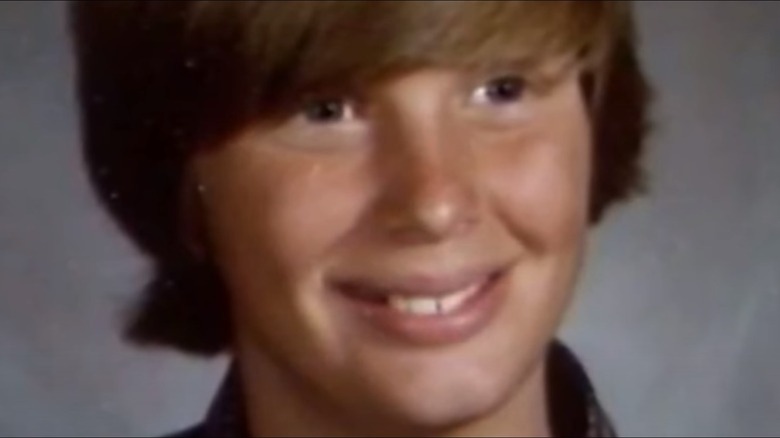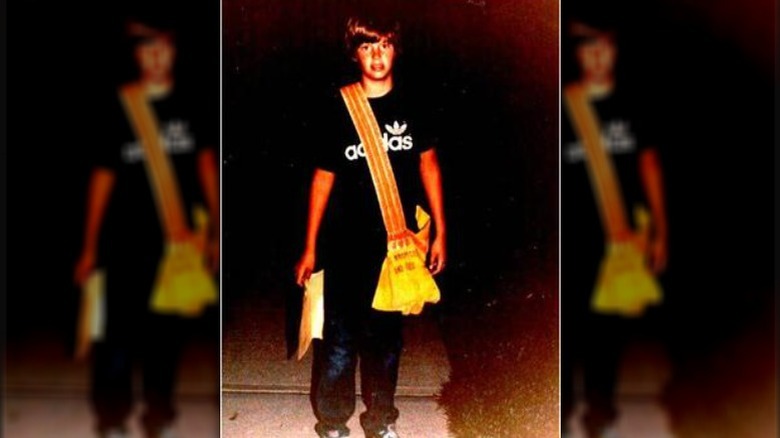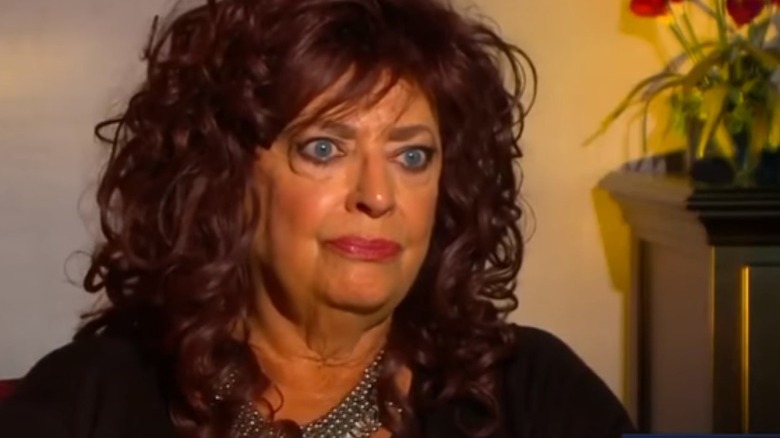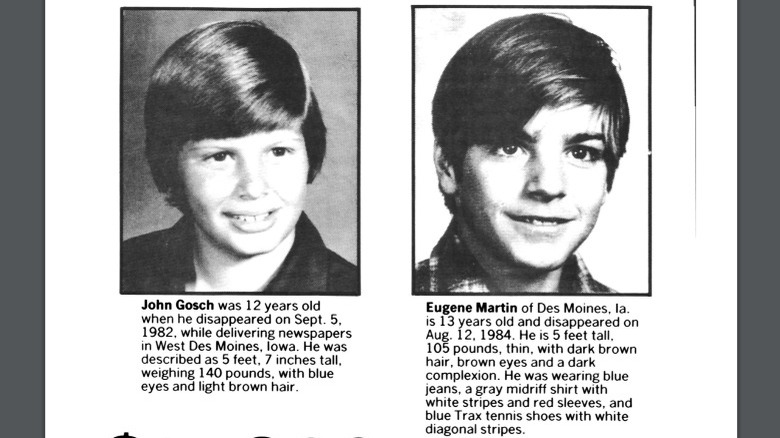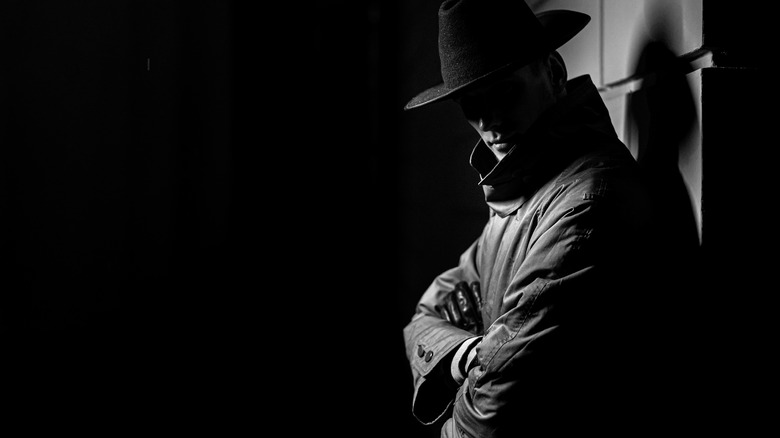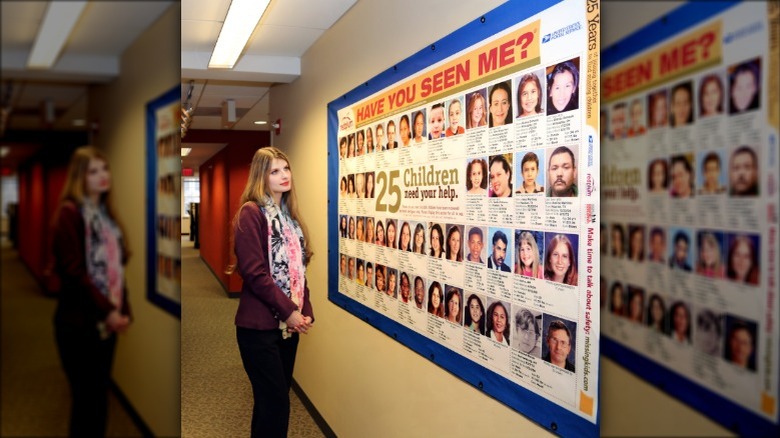The Tragic Story Of The Kidnapping Of Johnny Gosch
There's a reason that "Stranger Things" was such a runaway hit: The 1980s were one of the best decades in recent memory, and let's face it — things kind of went downhill from there. It wasn't all tie-dye, hair metal, and leggings, though. The 80s were also the decade of the so-called Satanic Panic, worry over the rise of games like Dungeons & Dragons, and the development of what we still know as Stranger Danger. That last one kicked off with the bizarre kidnapping of a 12-year-old paperboy named Johnny Gosch, and the story of what happened around his disappearance isn't just tragic, it's downright weird.
Gosch's disappearance came alongside other high-profile kidnappings, like the 1981 disappearance and murder of Adam Walsh. According to Slate, the media frenzy that surrounded these missing boys was something of a perfect storm. Journalists and politicians went all in with the insistence that there were scores of kidnappings happening all across the country, and even though that wasn't precisely true, it kicked off a massive campaign around the belief that strangers were all out to pick up some kids for terrible, nefarious purposes.
While Americans worried for their own children, the Gosch family found themselves right in the middle of a parents' worst nightmare — and 40 years later, they're still hoping for answers.
The disappearance of Johnny Gosch
Iowa Cold Cases says that the last time anyone saw Johnny Gosch was September 5, 1982. It was the very first thing that Sunday morning — at the crack of dawn — when the 12-year-old from West Des Moines, Iowa, headed out to deliver newspapers to the 37 houses on his paper route. He never made a single delivery, and he was never seen again.
It was unusual for Johnny to head out on his own, and he hadn't been entirely alone: He'd taken the family dog with him. Dachshund Gretchen found her way home without him, though, and her solo reappearance was just one of the early signs that something was dreadfully wrong. He was normally accompanied by his father, John, and there's no way to tell why things changed that day. Parents John and Noreen became suspicious when Gretchen returned alone and then, at 7:45 am, one of their son's paper route customers called to ask where their paper was. They knew something was definitely, dreadfully wrong. John later said, "We went searching and found his little red wagon." Of Johnny, there was no trace.
The police were notified about 45 minutes later and started out by heading out into the neighborhood and going from door to door. They were looking for anyone who had seen Johnny, or who had seen anything suspicious that morning. Unfamiliar cars, people hanging around where they shouldn't have been ... but they came up completely empty.
Noreen Gosch headed to Washington
It's impossible to imagine the pain of having a child go missing, and five years after Johnny Gosch's disappearance, his mother Noreen told the Associated Press: "The pain doesn't diminish. A lot of people say to us, 'I suppose it's easier now that it's five years.' But it isn't. You hear a particular song that was his favorite ... it pierces the heart."
In the years immediately following Johnny's disappearance, Noreen and his father, John, mounted what was essentially their own investigation independent of a police force that they believed wasn't doing nearly enough. She didn't just say it, either — they did something about it, and they undoubtedly saved lives. In 1984, a piece of legislation that she wrote was passed in Iowa and in eight other states. The so-called Johnny Gosch law mandated that as soon as a child was reported missing, law enforcement needed to get involved. Des Moines police chief William Moulder told USA Today that prior to the Gosch kidnapping, it was standard procedure to wait 72 hours before investigating a missing child report. He explained, "The idea was that most kids come home on their own. But Noreen Gosch woke us up. That wasn't good enough."
According to ABC News, that's probably saved a lot of lives. By the time 72 hours pass, leads, evidence, and the memories of anyone who might have seen something have faded ... along with hope.
The pedophile theory
According to Slate, Noreen Gosch testified before Congress in those early years, and part of her statement involved her belief that her son had been abducted by the North American Man/Boy Love Association. Her statement attempted to draw attention to the "organized pedophilia operations in this country," and as heartfelt as her speeches may have been, they had a very strange impact.
Everyone from politicians to journalists — including ABC's famous Peter Jennings — latched onto the story and warned that Gosch's disappearance heralded some seriously dark days ahead. If it could happen in Des Moines — the embodiment of America's wholesome, middle-class, and coincidentally white communities — it could happen anywhere. And the powers-that-be warned that it would.
Things snowballed: Even as journalists warned about the death of the American dream, lawmakers scrambled to write and pass legislation that would set new guidelines for background checks on individuals who wanted to work with children and harsher punishments for those convicted of child-related crimes. It went all the way to the top, with President Ronald Reagan even lauding Iowa's commitment to "cracking down on crime." Laws were made tougher, citizens' watch programs were established, and still, Johnny Gosch remained among the missing.
The eeriely similar disappearances of Eugene Martin and Marc Allen
A few years after Johnny Gosch went missing, the Associated Press was reporting on something troubling — the nearly identical disappearance of another Iowa boy, named Eugene Martin. Martin, says Iowa Cold Cases, was 14 years old when he was reported missing on August 12, 1984. Again, it was a Sunday morning, and again, he vanished while delivering the Des Moines Register to those along his route. Although Martin typically walked his route with his older brother, he happened to be alone that day — just like Gosch had been.
No official connection has ever been made between the crimes, but many think they're just too similar for things to be a coincidence. At the time, law enforcement issued a public appeal for information on both boys, saying witnesses had seen Martin having a seemingly friendly conversation with a 30-something man just before he disappeared. In spite of a $94,000 reward — $25,000 of which was offered by the paper the boys had been delivering — no leads ever materialized.
Then, on March 20, 1986, 13-year-old Marc Allen was reported missing from the Des Moines area. He wasn't a paperboy, but as he was the same age and suffered the same mysterious, evidence-free disappearance. According to Iowa Cold Cases, there is also no concrete evidence to connect him to either previous disappearance, but like the others, he also remains missing.
The faces on the milk cartons
Breakfast in the 1980s wasn't always a carefree meal, it usually came with a reminder that there were kids that were still missing. Those reminders, of course, came courtesy of the morning's milk carton, but those pictures weren't always there — they started with Johnny Gosch and Eugene Martin.
According to Iowa Cold Cases, it was a relative of Eugene Martin's who reached out to the company president of Anderson & Erickson Dairy. After seeing photos and flyers of the missing boys, the A&E Dairy employee asked if their photos and information could be put onto the milk cartons, too — where thousands and thousands of people would see it every morning. Other Iowa dairies started doing the same thing, and it wasn't long before everyone got on board, across the country. (There's a footnote to this, too: Although Etan Patz is often said to be the first boy on a milk carton, that's only partially true. His photo was the first to be circulated nationwide, while Gosch and Martin inspired the launch of the program.)
At the height of the program, hundreds of dairies were running the campaign, and shockingly, there is only one case where it worked. Neighbors recognized Bonnie Lohman from her photo on the milk carton and contacted police, only to find that she had been abducted by her stepfather and mother. She was happily reunited with her father.
The other Johnny Gosch
While there were no concrete leads or sightings in the Johnny Gosch case, there were a number of bizarre ... let's call them "almost sightings." What was arguably the weirdest happened in 1990. Noreen Gosch had what must have been the shock of her life when, according to the Los Angeles Times, the body of John E. Gosch was recovered from where he had been dumped in a ditch in Mexico. Noreen's son, incidentally, was John D. Gosch.
Coincidence? It was, and even as law enforcement confirmed the identity of the dead man, they found more coincidences — including the fact that the John Gosch birthdays were just about 2 weeks apart. Des Moines police ultimately discovered and confirmed that the John Gosch found in Mexico was from a Gosch family in Washington state. They had adopted the boy in 1980 and given him the eerily similar (yet undeniably common) name.
Not eerie enough? Just a week before John E. Gosch's body was found, Des Moines police were in Mexico, investigating a sighting not of Johnny Gosch, but of the other paperboy whose disappearance was often connected with his, Eugene Martin. Noreen later commented: "I feel terrible. This whole coincidence is just unbelievable. It would be such a relief to have it over. I'd rather have the bad news now over later."
The fraud cases
Where some see a family that deserves sympathy, others see an opportunity. It's sadly not surprising that was the case with the Gosch family, who was targeted by a teenage con artist in 1985. It started when Johnny Gosch's parents got a letter from someone claiming to belong to the motorcycle gang who had kidnapped him. The letter, says The New York Times, claimed that he had been grabbed and sold into slavery as part of a much larger human trafficking ring. He was alive, it assured his parents, but he was being held against his will in Mexico City. It was signed "Samuel Forbes Dakota."
Noreen Gosch believed the letter was real and sent the letter-writer a series of checks for a total of around $11,000. Meanwhile, the FBI issued a warrant for the arrest of "Samuel Forbes Dakota," a move that she condemned. Dakota, it turned out, wasn't an informant at all — he was 19-year-old Robert Herman Meier. The Associated Press reported that Meier was ultimately arrested as he attempted to cross the border to Canada via Buffalo, New York, and was indicted on fraud charges at the federal level.
It wasn't the only time the Gosch family was targeted, either. In 1986, UPI reported on another incident where a man named David James Schultz was arrested after trying to get money from the family in exchange for supposed information on Johnny's whereabouts. Once again, Mexico was named as the boy's ultimate location.
Strange sightings
The years went on and on, as they tend to do with infuriating indifference. And every so often, something strange would happen in the case. In 1985, UPI reported that a woman in Sioux City, Iowa had gone to a grocery store, paid, and gotten some change back. In that change was a dollar bill with a message on it: "I am alive. Johnny Gosch." It sounds like something that would be easy enough for anyone to write, but when the woman took it to the Gosch family and they took it to a handwriting expert, that's when the writing was confirmed as belonging to the missing boy.
Equally noteworthy — especially as far as Noreen Gosch was concerned — was the testimony of a convicted sex offender named Paul Bonacci. The Des Moines Register says that Bonacci first came to the attention of law enforcement during the investigation into Gosch's disappearance, when he claimed that he had been one of the men who had grabbed the boy and shoved him into a car.
Amid debate surrounding his 1991 parole appeal, it was reported that Bonacci claimed Gosch had been held in Sioux City before being moved out of the state. He had also claimed that he had seen the boy four years after his abduction, when he was being held in Colorado — still a prisoner. Law enforcement said they had no intentions to follow up on Bonacci's claims.
A mysterious midnight visit
Fast forward to 1997, and that's when Noreen Gosch claimed she had a midnight visitor: Johnny. It wasn't until 1999 that the visit was reported by The Des Moines Register, and Noreen claimed she had waited so long because "it was in his best interests." She said that Johnny had told her that he was in danger and needed to remain in hiding, and she added that she didn't even tell Johnny's father, John. The story apparently only came out when she was called to the stand to testify at a hearing involving Paul Bonacci, the convicted sex offender who The Des Moines Register says claimed to have been one of the men who had abducted Johnny in the first place.
She testified that it was about 2:30 in the morning when the now-27-year-old Johnny knocked on her door, showed her a birthmark to prove it was him, and then talked to her for about an hour and a half.
Details were scarce, but Noreen said there was another man with him, and before he answered anything, he'd look to the other person for permission. She finished: "He didn't say where he is living or where he was going."
The photos on the doorstep
Johnny Gosch had been missing for nearly 25 years when, on one morning in 2006, his mother walked out the front door to her home and found a package containing several photos. According to the Pittsburgh Post-Gazette, it was August when Noreen Gosch opened the package to see several photos of her son. He was laying on a bed, bound and gagged, apparently wearing what he had been on the morning he vanished. Was it Johnny? And if it was — or even, if it wasn't — who were the other two boys in one of the photos with him? They, too, were similarly restrained.
The initial response from law enforcement was that the photos seemed to be authentic, and the consensus was that maybe it was him. However, in September, a former sheriff's office investigator from Florida seemed to debunk the whole thing. NBC News said the retired officer came forward to say that he clearly remembered seeing the photos and then investigating the case. He claimed the photos were of entirely different boys, pre-dated the Johnny Gosch case, and had been taken voluntarily.
However, this ended up being about as straightforward as everything else in the kidnapping. By the end of September, The Des Moines Register was reporting that Florida's Hillsborough County sheriff's office didn't actually have any proof they'd investigated the photos at all.
Jeff Gannon or Johnny Gosch?
In 2008, Vanity Fair did a profile piece on Jeff Gannon, the controversial White House reporter who had been born James Guckert before he latched onto the so-called "Jeff Gannon brand." He went from male escort and auto repair shop bookkeeper to correspondent at the White House fairly quickly, so needless to say, there were a lot of questions. Bizarrely, there was also a massive conspiracy theory that suggested Gannon was actually Johnny Gosch.
The theory, recounts Salon, essentially says that Noreen Gosch was correct in insisting that her son had been kidnapped into a pedophilia ring, and that organization was based in Washington, DC. As he grew up, he was transferred into the care of the CIA, where he was first brainwashed, then re-trained to be an escort. From there, he was given a new identity as Jeff Gannon and sent to the White House.
Farfetched and unlikely? Absolutely, especially considering Gosch and Guckert aren't anywhere near the same age. The temptation to connect a decades-old cold case with some Washington DC drama is just the sort of thing that conspiracy theorists love, though — especially when the two men in question happen to have the same initials.
Gosch's disappearance changed how we deal with kidnappings
Johnny Gosch remains missing to this day, and his disappearance has had a lasting impact on the nation. According to The Des Moines Register, the Johnny Gosch case changed the way missing children cases were reported and investigated. Feeling like they were forced to take matters into their own hands, Noreen and John pushed for changes in the way law enforcement dealt with kidnappings. And it made a huge difference: At the time Johnny went missing only about 66% of children who were kidnapped were found and returned. In 2017, the National Center for Missing and Exploited Children said that had risen to around 98%. Vice president Robert Lowery explained: "What happened with Johnny Gosch is what opened the doors for the National Center for Missing and Exploited Children."
Noreen Gosch in particular has been seen as hugely controversial, especially in regard to her determination that her son of kidnapped into a child sex ring. She says, however: "You show me somebody who isn't a little controversial when it comes to making positive chances, and I'll show you someone who's never done a damn thing in their life."
Johnny Gosch's little red wagon still goes on display fairly regularly in Iowa, says Little Village. It was at the state fair in 2017, a reminder not only of the questions that still surround his disappearance, but as a reminder of all the lost, missing, abducted, and exploited children still in danger.
